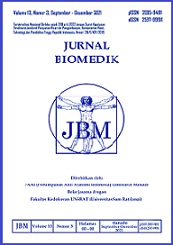PERAN INFLAMASI DALAM PATOFISIOLOGI SEPSIS DAN SYOK SEPTIK PADA ANAK
DOI:
https://doi.org/10.35790/jbm.1.3.2009.831Abstract
Abstract: As one of the main causes of death in critically patients in intensive care unit, sepsis remains a health problem in developing and industrialized countries. Sepsis spectrum varies from invasion of microbes into the bloodstream associated with early signs of circulatory disorders (tachycardia, tachypneu, peripheral vasodilatation, fever, hypothermia) to circulatory collapse, multiple organ failures, and even death. Sepsis and septic shock occurs due to uncontrolled inflammation and immune system failure. Activated CD4 T cells are programmed to secrete mediators that have either one of two distinct and antagonistic profiles: proinflammatory [type 1 helper T-cell (Th1)] or anti-inflammatory [type 2 helper T-cell (Th2)]. There is a complex interaction between these proinflammatory and anti-inflammatory mediators in sepsis and septic shock. The balance of these two kinds of mediators helps the involved tissues in repairing and healing processes. High mortality rates of sepsis occur when/if the levels of both kinds of mediators are high. Prognosis of patients is affected by the severity of infections, previous health status, and host responses. Understanding the role of inflammation in the pathophysiology of sepsis and septic shock may improve the ability of health workers in diagnosis and handling of sepsis patients.
Key words: Sepsis, septic shock, inflammation, proinflammatory and antiinflammatory mediators.
Abstrak: Sebagai salah satu penyebab utama kematian terutama pada penderita di unit perawatan intensif, sepsis tetap merupakan masalah kesehatan baik di negara berkembang maupun negara maju. Spektrum sepsis bervariasi dari invasi mikroba ke aliran darah dengan tanda awal gangguan sirkulasi (takikardia, takipnu, vasodilatasi perifer, demam atau hipotermi) hingga kolaps sirkulasi, kegagalan sistem multiorgan bahkan kematian. Sepsis dan syok septik terjadi akibat tidak terkontrolnya inflamasi dan kegagalan system imun. Sel T CD4 teraktivasi menyekresi mediator yang memiliki salah satu dari dua profil yang berbeda, yakni: proinflamasi [sel T-helper tipe 1 (Th1)] atau anti-inflamasi [sel T-helper tipe 2 (Th2)]. Terdapat interaksi yang kompleks antara sejumlah mediator proinflamasi dan anti inflamasi pada sepsis dan syok septik. Keseimbangan antara kedua jenis mediator dapat membantu perbaikan dan pemulihan jaringan. Angka kematian akan tinggi bila kadar keduanya tinggi. Prognosis penderita dipengaruhi oleh beratnya infeksi, status kesehatan sebelumnya dan respon host. Dengan memahami kontribusi inflamasi dalam patofisiologi sepsis dan syok septik dapat meningkatkan kemampuan tenaga kesehatan dalam menegakkan diagnosis dan menangani penderita sepsis.
Kata kunci: Sepsis, syok septik, inflamasi, mediator proinflamasi dan anti-inflamasi
Downloads
Issue
Section
License
Penyunting menerima sumbangan tulisan yang BELUM PERNAH diterbitkan dalam media lain. Naskah yang masuk dievaluasi dan disunting keseragaman format istilah dan cara penulisan sesuai dengan format penulisan yang terlampir dalam jurnal ini.
Segala isi dan permasalahan mengenai tulisan yang yang diterbitkan dalam jurnal menjadi tanggung jawab penuh dari penulis.







